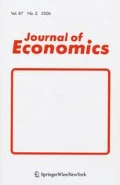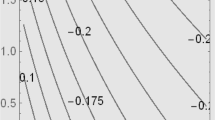Abstract
We consider industries where the equally skilled workers/members of firm-specific monopoly unions can be grouped according to different reservation wages. We show that, in absence of active antidiscrimination policy, discriminatory wage contracts across groups of employees may emerge, in equilibrium, under either oligopoly or a perfectly competitive product market. We subsequently propose that to combat wage discrimination a benevolent policy maker should under either market structure subsidize the employment of the low reservation wage group. The reason is that taxing wage discrimination, as an alternative antidiscrimination policy, always entails a welfare loss relative to the no policy/wage discrimination status quo.
Similar content being viewed by others
References
Arrow KJ (1972) The theory of discrimination. In: Ashenfelter O, Rees A (eds) Discrimination in the labor markets. Princeton University Press, Princeton
Azam J-P, Rospabe S (2007) Trade unions vs. statistical discrimination: theory and application to post-apartheid South Africa. J Dev Econ 84: 417–444
Becker GS (1957) The economics of discrimination. University of Chicago Press
Binmore K, Osborne M, Rubinstein A (1992) Noncooperative models of bargaining. Handb Game Theory 1: 180–225
Burda M, Funke M (1993) German trade unions after unification—third degree wage discriminating monopolists. Rev World Econ 129(3): 537–566
Cabinet Office Strategy Unit (2003) Ethnic minorities and the labour market: final report. Cabinet Office, London
Clark A, Oswald A (1993) Trade union utility functions: a survey of union leaders views. Ind Relat 32(3): 391–411
Commission of the European Communities (2004) Equality and non-discrimination in an enlargement union, Green Paper
Corneo G (1995) National wage bargaining in an internationally integrated product market. Eur J Political Econ 11: 503–520
De Fontenay C, Gans J (2005) Vertical integration in the presence of upstream competition. Rand J Econ 36(3): 544–572
Dixit A (1979) A model of a duopoly suggesting a theory of entry barriers. Bell J Econ 10: 20–32
Drydakis N, Vlassis M (2010) Ethnic discrimination in the Greek labour market: occupational access, insurance coverage, and wage offers. Manchester School (published on line 15 January 2010)
Eurobarometer 57.0 (2003) Executive Summary
European Trade Union Confederation (2003) Migrant and ethnic minority workers: challenging trade unions
Gahan P (2002) (What) do unions maximise? Evidence from survey data. Camb J Econ 26: 279–298
Hartog J, Theeuwes J (1992) Labour market contracts and institutions: a cross-national comparison. Amsterdam, North-Holland
Leigh D (1980) Racial differentials in union relative wage effects: a simultaneous equations approach. J Labor Res 1(1): 95–114
Myles G, Naylor R (1995) Do unions reduce discrimination? A model of Nash bargaining between a union and an employer with discriminatory tastes. Labour Econ 2(3): 249–274
Nash J (1953) Two-person cooperative games. Econometrica 21(1): 129–140
Nickell S, Andrews M (1983) Unions, real wages and employment in Britain 1951–1979. Oxford Economic Papers, vol 35, pp 183–206
Oswald AJ (1982) The microeconomic theory of the trade union. Econ J 92: 269–283
Roth A (1979) Axiomatic models of bargaining. Springer, Berlin
Svejnar J (1986) Bargaining power, fear of disagreement, and wage settlements: theory and evidence from U.S. industry. Econometrica 54(5): 1055–1078
Vendrik M, Schwieren C (2010) Identification, screening and stereotyping in labour market discrimination. J Econ 99: 141–171
Vlassis M (2003) Wage centralization and the scope of firm-union bargaining in oligopoly: “efficient bargains” or “labour demand”?. Manch School 71(3): 308–329
Author information
Authors and Affiliations
Corresponding author
Rights and permissions
About this article
Cite this article
Vlassis, M., Drydakis, N. Wage discrimination and antidiscrimination policy in unionized industries. J Econ 105, 45–62 (2012). https://doi.org/10.1007/s00712-011-0241-9
Received:
Accepted:
Published:
Issue Date:
DOI: https://doi.org/10.1007/s00712-011-0241-9




